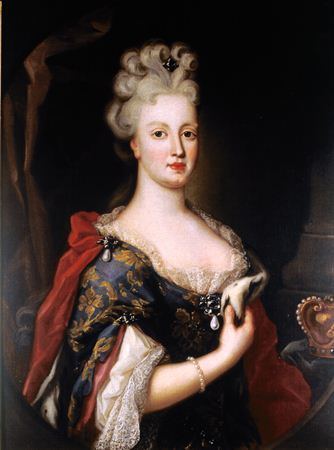House BraganzaHabsburg Name Maria of | Signature | |
 | ||
Tenure 27 October 1708 – 31 July 1750 Issue Barbara, Queen of SpainPedro, Prince of BrazilJose I, King of PortugalPedro III, King of Portugal Mother Eleonor Magdalene of Neuburg Grandchildren John VI of Portugal, Maria I of Portugal Similar People John V of Portugal, Barbara of Portugal, Joseph I of Portugal, Mariana Victoria of Spain, Maria I of Portugal | ||
Archduchess Maria Anna of Austria, Duchess of Lorraine
Maria Anna of Austria (Maria Anna Josepha; 7 September 1683 – 14 August 1754) was an Archduchess of Austria and Queen consort of Portugal. She was also Regent of Portugal from 1742 until 1750 during the illness of her husband King John V of Portugal.
Contents
- Archduchess Maria Anna of Austria Duchess of Lorraine
- Archduchess Maria Anna of Austrias Tiara
- Family
- Queen Consort of Portugal
- Regency
- Marriage and children
- In Culture
- Titles and styles
- References
Archduchess Maria Anna of Austria's Tiara
Family
Born Maria Anna Josepha, she was a daughter of Holy Roman Emperor Leopold I and Eleonor Magdalene of Neuburg. Maria Anna was a sister of Holy Roman Emperors Joseph I and Charles VI. Through her brother Charles, she was an aunt of Maria Theresa, Austria's first queen regnant.
Queen Consort of Portugal
On 27 October 1708 Maria Anna of Austria married John V, King of Portugal. She would cease to be the Queen Consort of Portugal on 31 July 1750, when her husband died. During her time as Queen Consort of Portugal, she acted as regent during times of her husband's illness.
Once she was head of her household, Maria Anna reformed her court and its customs to follow the traditions and costumes of the traditional Queens of Portugal. Her greatest influence on the court, and Portuguese nobility as a whole, was the increase of segregation between men and women, as well as between servants and masters. Like John, Maria Anna had an exubrant taste, and this was best shown in her famous parties. Often lasting several days, she would invite the nobility from all over the country and hold a magnificent festival, often in concurrence with a saintly holiday, though religion played a small part in her parties.
Regency
In 1742 Maria Anna took over power as regent after her husband suffered a stroke, which left him partially paralyzed. When John V died on 31 July 1750 she gave up power to their eldest son Joseph I of Portugal.
She died while in residence in the Palace of Belem in 1754. After her death, she was buried in Lisbon, but her heart was brought to Vienna and buried there in the imperial crypt.
Marriage and children
On 27 October 1708 she married her maternal first cousin John V of Portugal to become Queen consort of Portugal. She was the mother of six children:
In Culture
Maria Anna, along with her husband and children, is a central character in Jose Saramago's novel Baltasar and Blimunda (1987).
